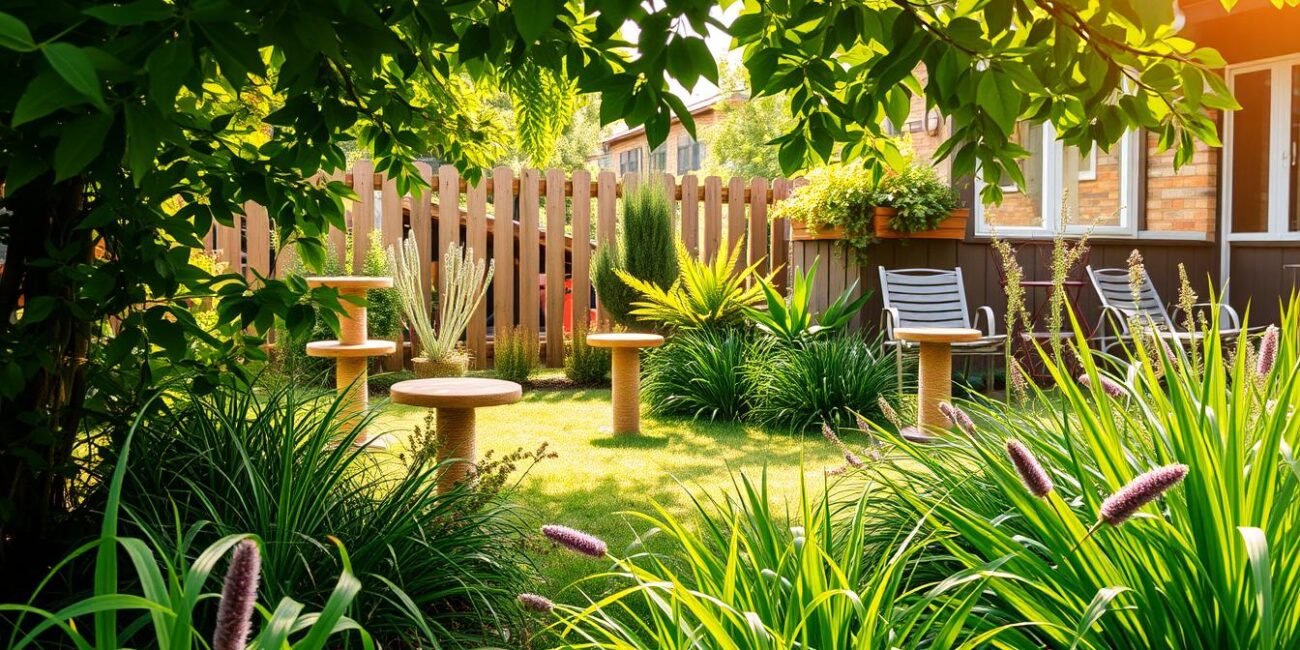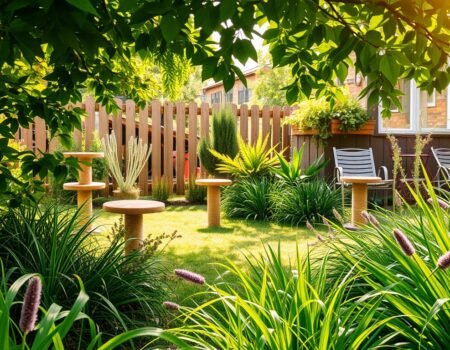Creating outdoor spaces for cats and keeping your garden beautiful requires careful planning. For U.S. pet owners, it’s important to choose plants that are safe for cats. This means picking non-toxic plants and adding fun features for your pets.
Make your garden cat-friendly by adding plants that cats love. Include catnip, wheatgrass, or spider plants for a safe treat. Also, add raised beds or vertical structures like scratching posts. These features keep your cats busy and add beauty to your garden.
Don’t forget about safety. Use secure fencing to keep your cats in and sunlight out. Stay away from harmful chemicals and choose organic pest control instead. With the right design, your garden can be a safe and happy place for your cats and your flowers.
Key Takeaways
- Identify and avoid toxic plants like lilies to ensure pet safety
- Integrate cat-safe greenery such as wheatgrass or catnip
- Use vertical spaces and secure fencing for behavioral enrichment
- Choose organic pest control methods over harmful chemicals
- Balance aesthetics with functional features like scratching zones
Why Choose Cat-Friendly Plants?
Did you know your garden can be a fun place for your cat? Cat-friendly plants make it safe for them to explore. They turn your yard into a lively spot that everyone can enjoy.
Benefits for Your Feline Friends
Non-toxic plants keep your cat safe and let them be their natural selves. They help with digestion, provide exercise, and offer a cozy place to hide. Plants like catnip or wheatgrass keep them busy and happy.
Here are some great things about cat-friendly plants:
- They prevent poisoning from harmful plants
- They support healthy chewing habits
- They offer cool spots for naps
Enhancing Your Garden Aesthetics
Safe plants don’t have to be boring. Many are colorful or have interesting textures that make your garden look great. Mix tall grasses with flowers or use thyme as a fragrant ground cover.
| Plant | Aesthetic Feature | Cat Benefit |
|---|---|---|
| Spider Plant | Architectural green-and-white stripes | Safe for occasional nibbling |
| Calendula | Bright orange/yellow blooms | Anti-inflammatory properties |
| Lemongrass | Feathery tropical appearance | Natural insect repellent |
Where you put the plants matters. Group cat-friendly plants together to keep them happy. This way, your garden stays beautiful and your cat has their own fun area.
Safe Plants for Cats: An Overview
Creating a cat-friendly garden is easy when you know which plants are safe. This guide shows you ASPCA-approved vegetation that looks good and is safe for cats. This way, you can make a space where cats can play without worry.
Popular Options to Consider
Here are eight plants that are safe for cats and great for gardening:
- Chlorophytum comosum (Spider Plant): Thrives in indirect light with weekly watering
- Nepeta cataria (Catnip): Requires full sun and well-drained soil
- Phalaenopsis (Moth Orchid): Prefers humid environments and bark-based potting mix
- Calathea lancifolia (Rattlesnake Plant): Loves shaded areas with moist soil
- Echeveria (Hens and Chicks): Needs gritty soil and minimal watering
- Nephrolepis exaltata (Boston Fern): Grows best in cool, humid conditions
- Thymus vulgaris (Thyme): Requires full sun and occasional pruning
- Maranta leuconeura (Prayer Plant): Flourishes in medium-light with distilled water
How to Identify Safe Plants
Here are three ways to make sure a plant is safe for cats:
- Check the ASPCA’s updated toxic plant database before buying
- Look for smooth-edged leaves and no milky sap
- Ask nursery staff about pet-safe alternatives
“When in doubt, stick with plants that have clear safety documentation. Many common garden favorites have cat-friendly counterparts.”
Look for plants with matte leaves, sturdy stems, and mild fragrances. Avoid plants with berries, thorns, or fuzzy textures. These might tempt cats to chew too much.
Best Herbs for Cat Enjoyment
Growing herbs that cats love adds fun to your garden. These plants keep cats safe and happy. They offer natural fun, from playful nibbling to sniffing around. Here, we’ll look at two herbs that cats adore and how to grow them well.
Catnip: The Ultimate Feline Favorite
Catnip (Nepeta cataria) makes 70% of adult cats very happy. It’s a hardy plant that grows well in USDA zones 3-9. It likes:
- 6-8 hours of sunlight every day
- Soil that drains well and has a pH of 6.1-7.8
- Watering once a week (don’t let the roots get too wet)
Harvest the leaves when the plant blooms for the best effect. Dry the sprigs upside-down in a cool, shaded spot. Pro tip: Move the plant to a new spot every year to keep the soil rich.
Valerian Root: An Alternative Delight
Valerian (Valeriana officinalis) has a calming effect, unlike catnip’s excitement. It has pretty flowers that attract bees and butterflies. It’s safe for cats to play with. To grow well, it needs:
| Factor | Requirement |
|---|---|
| Sun Exposure | Full sun to partial shade |
| Soil Type | Moist, pH 5.5-7.0 |
| Maturity Period | 2-3 years for full root development |
Trimming the flowers helps the roots grow stronger. Store dried roots in airtight containers. Their smell gets stronger over time.
Flowering Plants That Are Safe
Bright blooms can make your outdoor space lively and safe for curious cats. Choosing the right flowering plants keeps your garden colorful and safe. Let’s look at some vibrant options that are safe for cats.
Top Choices for a Colorful Garden
Here are three cat-safe flowers that add color and are easy to care for:
- Zinnias: These drought-tolerant annuals come in neon pink, red, and yellow. They need full sun and should be watered weekly. Their strong stems can handle playful cat swats.
- Roses (thornless varieties): Choose David Austin or Knock Out breeds. They need 6+ hours of sunlight and should be pruned to keep them blooming.
- Snapdragons: These tall flowers come in purple, white, or bi-colored. They grow best in well-drained soil and need regular deadheading for continuous blooms.
Features of Cat-Safe Flowers
Non-toxic blooms have traits that are good for pets and pollinators:
Most pet-friendly garden flowers have strong fragrances that attract bees but are safe for cats. Zinnias and snapdragons, for example, offer nectar without harming cats.
These plants also offer textural variety. Their fuzzy leaves or thick petals keep cats from chewing too much. Adding lavender or catmint creates zones that entertain pets and help local ecosystems.
Foliage Plants That Won’t Harm Cats
Lush greenery brings life to any space and keeps cats safe. Whether you’re creating an indoor jungle or an outdoor retreat, these plants are both beautiful and safe for pets.
Low-Maintenance Options
Seven hardy plants thrive with minimal care and resist cat nibbles:
- Spider Plants: Their arching leaves add playfulness. They’re safe for cats and clean the air
- Bamboo Palms: They bring tropical vibes with sturdy fronds. They do well in low light
- Parlor Palms: They’re compact, perfect for shelves. They love humidity and are non-toxic
- Boston Ferns: Their feathery texture is lovely. They prefer indirect light and moist soil
- Calathea: Their striking patterns are eye-catching. Their leaves fold up at night
- Peperomia: Their waxy leaves are safe. There are over 1,000 safe varieties
- Areca Palms: They’re tall and make a statement. They filter airborne toxins
How to Incorporate Foliage in Your Design
Here’s how to create cat-friendly greenery displays:
- Vertical gardens: Mount spider plants on wall shelves. Cats love batting at the leaves
- Edible arrangements: Group cat grass pots near safe plants. This redirects their chewing
- Textural contrast: Mix smooth bamboo stalks with crinkled calathea leaves
In busy areas, use heavy planters. Secure climbing palms with wall brackets. Rotate plants seasonally to keep your Indoor Plants for Cats display fresh.
Styling Your Cat-Friendly Garden
Turn your outdoor area into a cat paradise by mixing beauty with smart design. A well-thought-out garden keeps cats happy and safe around outdoor plants for cats. We’ll show you how to set up different zones and add features that meet their natural needs.
Creating Different Zones for Cats
Cats love spaces that let them act like they’re in the wild. Split your garden into three main areas:
- Play Zone: Add feather toys, tunnels, and climbing spots near safe grasses.
- Rest Zone: Put in shaded benches or high places with comfy bedding.
- Exploration Zone: Plant cat-friendly shrubs like wheatgrass in fun paths for them to hide and seek.
“Cats need both fun and safety outside. Zoning makes them feel in charge.”
Essential Garden Features for Felines
Focus on these key features for a useful space:
| Feature | Purpose | Installation Tip |
|---|---|---|
| Cat Grass Patches | Provides safe nibbling | Plant in movable containers for easy rotation |
| Shallow Water Features | Encourages hydration | Add floating toys to spark curiosity |
| Cat-Proof Fencing | Prevents escapes | Use angled mesh extensions at the top |
Add vertical features like scratching posts or cat trees near outdoor plants for cats to meet their climbing needs. Also, leave some soil open for digging – many cats love digging cool spots in summer.
Maintaining a Healthy Cat Garden
A cat-friendly garden needs regular care. This care keeps plants alive and safe for pets. It’s all about finding the right balance.
Natural Solutions for Pest Management
Non-toxic pest control begins with stopping pests before they start. Planting marigolds or basil can keep bugs away. For tougher problems, try mixing neem oil with water (1 tablespoon per quart) and spray it on leaves weekly. This method keeps aphids off without harming cats.
- Introduce ladybugs to combat aphid infestations
- Use crushed eggshell barriers around plant bases
- Create garlic spray by steeping minced cloves in water overnight
Controlling Fast-Growing Plants
Herbs like mint can spread fast if not kept in check. Here’s how to manage them:
- Plant in submerged pots with drainage holes
- Install underground root barriers 12″ deep
- Trim runners weekly during peak growing season
Keep an eye on your garden often. Check plant boundaries every 2-3 weeks. Also, rotate container positions to avoid soil depletion. This way, your garden stays healthy and safe for cats.
Common Plants to Avoid
Creating a safe garden for cats means knowing which plants are dangerous. Over 700 plant species are toxic to cats, with risks varying by USDA hardiness zones. This guide highlights 12 hazardous plants found in U.S. gardens and explains how to spot poisoning symptoms quickly.
Toxic Plants That Can Harm Cats
Some common garden plants contain chemicals that attack a cat’s nervous system or organs. These seven species cause the most emergency vet visits nationwide:
| Plant Name | Toxic Parts | Key Symptoms | High-Risk Zones |
|---|---|---|---|
| Lilies (Lilium) | All parts | Kidney failure, vomiting | Zones 4-9 |
| Sago Palm | Seeds, leaves | Liver damage, seizures | Zones 8-11 |
| Oleander | Leaves, flowers | Heart arrhythmia, drooling | Zones 8-10 |
| Autumn Crocus | Bulbs | Organ shutdown, bloody diarrhea | Zones 4-9 |
| Azaleas | Leaves | Weakness, coma | Zones 5-9 |
| Dieffenbachia | Stems | Mouth swelling, breathing issues | Indoor/Outdoor Zones 10-12 |
| Castor Bean | Seeds | Muscle tremors, dehydration | Zones 9-11 |
Other dangerous plants include:
- Tulips (bulbs cause stomach pain)
- Philodendron (leads to oral irritation)
- Yew (sudden heart failure)
Signs of Plant Toxicity in Cats
Cats show poisoning symptoms within 2-12 hours. Watch for these red flags:
- Excessive drooling or pawing at mouth
- Sudden vomiting or diarrhea
- Twitching muscles or loss of balance
| Time After Ingestion | Progression of Symptoms |
|---|---|
| 0-2 hours | Drooling, lip smacking |
| 2-6 hours | Vomiting, lethargy |
| 6-12 hours | Tremors, breathing changes |
“Never wait for symptoms if you saw your cat chew a toxic plant. Immediate action saves lives.”
Emergency Response Protocol:
- Remove plant material from the cat’s mouth
- Call your vet or ASPCA Poison Control (888-426-4435)
- Bring a plant sample to the clinic
Final Tips for a Purr-fect Garden
Creating a cat-friendly garden is all about mixing looks with safety. Choose plants like catnip or spider plants that are safe for cats. Make sure play areas are secure to keep your garden beautiful and safe for your pets.
Engaging Your Cats with Safe Toys
Use toys like Whisker City feather wands or Petstages Tower of Tracks for fun. These toys are safe and keep your cat active. Change toys every week to keep them interesting.
Stay away from toys with strings to avoid choking hazards. Cat grass planters from The Cat Ladies are great for safe grazing and fun.
Keeping Your Cats Safe Outdoors
Use a Tractive GPS tracker collar to keep an eye on where your cat goes. Make sure they have shaded spots in the summer with elevated catios from Habitat Haven. Use Safe Paw ice melts in winter to keep them safe.
Check fences often for holes and plant lavender to keep fleas away without harmful chemicals. Take your cat to the vet before the weather changes to prevent health issues. Use microchips and breakaway collars for extra safety. This way, your garden will be a safe and happy place for your cat.














No Comment! Be the first one.